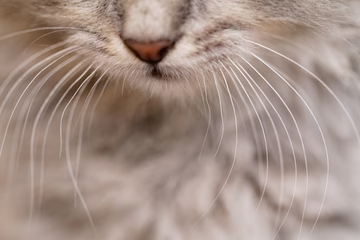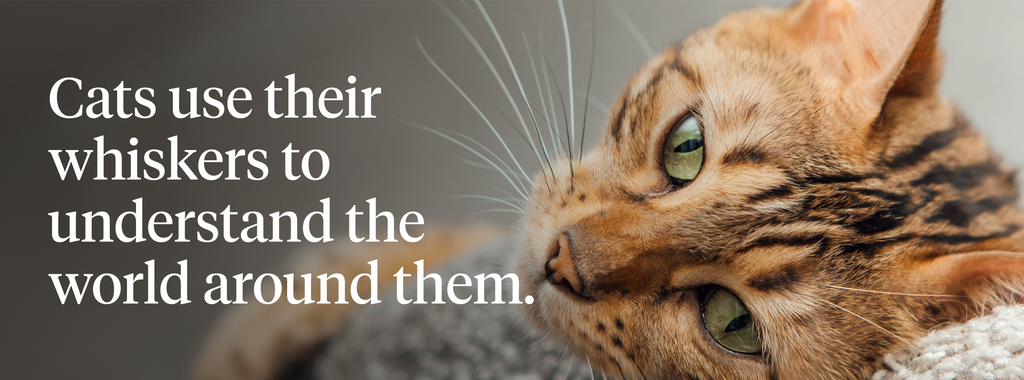5 Min Read
Do Cat Whiskers Grow Back?
Key takeaway

Why pet owners are switching to online vet care with Dutch
-
Prescriptions delivered free to you
-
Fast access to Licensed Vets over video
-
Unlimited video visits and follow-ups
Whiskers are one of the most defining features of cats and although they do grow back, trimming them is both inadvisable and unnecessary.¹ These specialized hairs — also known as vibrissae — can grow up to double the length of a cat’s regular hairs. They are also thicker and more deeply rooted than normal hairs. Furthermore, they are connected to both muscles and nerve endings, resulting in a high level of sensitivity.² More importantly, whiskers serve a vital purpose for our feline friends.
Cats use their whiskers to understand the world around them. Whiskers are the same width as the body, which helps a cat to accurately judge distances between objects, as well as determine how far away things are from their face or body.
Since these hairs are hypersensitive, they can easily detect even the slightest vibrations in the air, alerting the brain to a perceived obstacle or movement. Cats might also twitch their whiskers to familiarize themselves with their surroundings or to communicate their mood.³ Keep reading to learn more about this fascinating feline feature!
Why do Cats Have Whiskers?
Cats use their whiskers similar to the way we use our arms and hands; they help with spatial awareness. If the whiskers don’t fit into a space, the cat knows that its body also won’t fit. Whiskers are also handy for helping cats move around in low light or dark environments. They simply feel it out instead of using their eyesight, which is not as good as their sense of smell or whisker-based touch, anyway.²
Being able to get a sense of their surroundings in this way helps protect them from accidentally running into potential threats. Although your pet cat is unlikely to run into anything dangerous in your home, they will still use their whiskers to locate toys or food, especially if something has changed in their environment.²
Another important function of a cat’s whiskers is physical protection. We have eyelashes, cats have whiskers. Fine dust particles can potentially cause infections. Whiskers help catch most debris, preventing bacteria from entering the eye or face. While some cats also have eyelashes, most don’t, so whiskers usually play a big role in keeping the eyes free from unwanted particles.²

Whisker Shedding
It’s not uncommon for a cat’s whiskers to shed every so often. In fact, shedding whiskers is usually a sign that a cat is healthy and actively using them. Since whiskers are simply a type of hair, shedding doesn’t hurt at all and a replacement whisker usually grows back within 2-3 weeks.⁴
While shedding 1-3 whiskers is perfectly normal, a cat that sheds a lot of whiskers in one go may be feeling exceptionally stressed. Any change in environment, food, or other disruption can cause heightened stress levels in felines, so take note of your cat’s shedding if you’ve recently moved house or if your cat’s been exposed to other changes. Feline allergies can also cause excessive whisker shedding.⁵
What about trimming or plucking your cat’s whiskers? Bad idea. It won’t physically hurt them, but since our feline friends rely heavily on these special hairs, cutting them can be highly distressing. Their whiskers help them with everything from balance and touch to spatial awareness in the dark. Interfering with their whiskers can be a very confusing experience for them and there’s no physical reason to trim whiskers.⁶

Caring For Your Cat’s Whiskers
Whiskers themselves don’t have nerve endings (although they are attached to nerve endings deep in the skin). However, they’re still really important elements when it comes to your cat’s overall health and happiness. Like with any type of hair or fur, your cat's whiskers require some care from time to time. Here are a few tips and tricks to keeping them in top shape⁶:
- Don’t trim or pluck a cat’s whiskers.
- Use wide, shallow food and water bowls to prevent whisker fatigue.
- Regular grooming helps keep whiskers free from debris and bacteria
Your feline friend will naturally take care of their whiskers to a certain degree, but it’s a good idea for you to also give them some extra attention sometimes. Try adding some whisker care to your cat’s grooming routine. Your cat will thank you.
FAQs
How long does it take for a cat’s whiskers to grow back?
On average, it takes about 6-12 weeks for a feline facial whisker to grow back to the point where it’s fully functional again.
Is it painful for cats to lose whiskers?
No. The whiskers themselves don’t have nerve endings. Physically, cutting off a whisker would feel no different than when our hair gets cut. However, losing whiskers can be very upsetting for a cat on an emotional level, because they use their whiskers to interpret their environment.
Why shouldn’t you touch a cat’s whiskers?
Too much whisker stimulation can be overwhelming and uncomfortable for a cat. This can lead to extreme stress and anxiety. It’s also essential that whiskers remain clean in order to function properly.

Final Notes
Understanding why whiskers are so important can help you better understand your cat’s behaviors and needs. These sensitive facial hairs help your feline to move around and adjust to the world. Sensory input is felt by the whiskers and then gets interpreted by the brain; this is particularly useful in the dark.
Here at Dutch, we know that having a pet means constantly learning new things about them. Dutch provides you with reliable veterinary advice online from the comfort of your home. Find out more about our services and get all the answers you need about your furry companion when you book an online consultation with a vet.
Share
References
-
Ilievski, Stevce. “Do Cat Whiskers Grow Back? Yes, But Please Don’t Cut Them.” Petpedia, 27 Nov. 2022, https://petpedia.co/do-cat-whiskers-grow-back/.
-
“Why Do Cats Have Whiskers?” Edited by Zach Coston, Dutch, Dutch Pet Inc., 25 Apr. 2022, https://www.dutch.com/blogs/cats/why-do-cats-have-whiskers#:~:text=2-,Taking%20Care%20of%20Your%20Cat's%20Whiskers,them%20and%20keep%20them%20healthy.
-
Blue Cross Editorial Staff. “Why Do Cats Have Whiskers?” Blue Cross, 28 Mar. 2019, https://www.bluecross.org.uk/advice/cat/why-do-cats-have-whiskers#:~:text=Whiskers%20are%20the%20same%20width,slightest%20vibration%20in%20the%20air.
-
Bowen, Jill. “CATS’ WHISKERS SERVE AS A KIND OF RADAR.” Roanoke Times, 2 Feb. 1997, https://scholar.lib.vt.edu/VA-news/ROA-Times/issues/1997/rt9702/970202/02030002.htm. Accessed 19 Jan. 2024.
-
Webber, R. C. “Dear Dr. Universe: Why Do Cats Lose Their Whiskers?” Ask Dr. Universe, Washington State University, 26 Nov. 2018, https://askdruniverse.wsu.edu/2017/12/18/why-do-cats-lose-their-whiskers/.
-
“Why Do Cats Have Whiskers?” Edited by Zach Coston, Dutch, Dutch Pet Inc., 25 Apr. 2022, www.dutch.com/blogs/cats/why-do-cats-have-whiskers.
